The Hexa-X-II Project has released its newest research deliverable, D5.3, advancing the field of 6G technology. Originating from Work Package 5 (WP5), this report details initial designs and validation of technologies and architectures of 6G devices and infrastructure.
Investigating Reflective Intelligent Surfaces
D5.3 models RIS-based hardware solutions offering enhanced propagation diversity. 3D radiation patterns are simulated, as well as measured, based on prototypes. RIS system integration aspects are clarified by looking at control options and listing the necessary functional properties and control protocols.
Proposing SoC architectures
Advanced DSP and AI capabilities are essential for future 6G systems. They require specific signal processing architectures, building on a RISC-V processor and scalable AI accelerators. A scalable SoC approach integrating processors and accelerators is proposed. In particular, it considers security and trust aspects through a holistic HW/SW approach. Additionally, energy harvesting and power management capabilities are designed based on combining multiple energy sources.
Pioneering ultra-low-energy devices
Battery-operated and energy-neutral IoT devices require challenging design approaches to achieve very low power consumption. Several techniques exploiting duty-cycling, wake-up radios, energy harvesting, energy-aware and self-contained protocols, and tinyML are proposed. Additionally, a proof-of-concept energy-neutral device is presented, validating the proposed ambient backscattering approach.
Exploring sub-THz architectures
D5.3 considers sub-THz bands, which promise a huge throughput and presents optimised sub-THz transceiver designs that maximise the energy efficiency of related hybrid MIMO architectures. It reviews the most important hardware non-idealities affecting the end-to-end performance of sub-THz radios, with a special focus on phase noise. It also considers alternative architectures based on resonant tunnelling diodes or switched-beam antenna lenses.
For a more detailed exploration, please read the full deliverable and check out the accompanying presentation.

